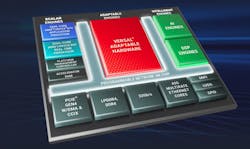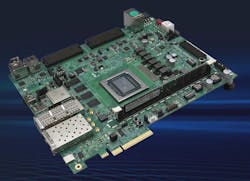Xilinx’s Adaptive Compute Acceleration Platform (ACAP) has been around for a number of years. The company filled out the mid-range Versal Prime and high-end Versal Premium computing solutions first. The new Versal AI Edge, however, targets the low end of the spectrum where efficient artificial-intelligence (AI) and machine-learning (ML) applications can be quite valuable. Xilinx isn’t alone in attacking this space, but the combination of AI/ML acceleration, FPGA configurability, a high-speed fabric, and an Arm-based compute cluster provides significant benefits in rapid time-to-market as well as hardware and software configurability.
The Versal AI Edge series uses the architecture like the rest of the Versal family. A programmable-network-on-chip connects major components such as the adaptable hardware, which is Xilinx’s flagship FPGA fabric (Fig. 1). The other components, including communication and the AI engines, are tailored to edge computing that has different AI/ML needs than other markets like cloud computing.
The AI Engine for the Versal AI Edge series uses more compact numeric formats like INT4 and BFLOAT16 (Fig. 2). This makes it possible to build ML models that provide accuracy comparable to implementations using larger values. It’s a common approach to AI accelerators that target edge applications where trained models are often identifying images or trends.
The series also doubles the amount of data memory to 64 kB and adds a new memory tile to the designs with up to 32 MB of additional high bandwidth memory. Overall, the system is designed to deliver 4X the ML compute power with half the latency compared to other platforms, e.g., GPU-base solutions. Of course, your mileage may vary.
The Versal AI Edge series targets a range of applications, including demanding areas such as automotive advanced driver-assistance systems (ADAS) and automated driving. It also incorporates Ethernet and CAN FD support. ML models can be used to analyze radar, LiDAR, and camera streams in real-time. The series meets standards such as ISO 26262, IEC 61508/62061/13849/61511, EN 60601 (medical), and DO-254/178. All chips are suitable for rugged applications where size, weight, and power (SWaP) are important while staying within a designated thermal envelope.
The Versal AI Edge series features lots of software support, including the Xilinx Vitis software platform and the Vivado Design Suite. Xilinx also has a number of application-oriented stacks (Fig. 3).
Developers can get started by using the Versal AI Core ACAP VCK190 Evaluation Kit (Fig. 4). Software tools will be available at the end of 2021, while the hardware and kit is expected to arrive in the second half of 2022.
About the Author
William G. Wong
Senior Content Director - Electronic Design and Microwaves & RF
I am Editor of Electronic Design focusing on embedded, software, and systems. As Senior Content Director, I also manage Microwaves & RF and I work with a great team of editors to provide engineers, programmers, developers and technical managers with interesting and useful articles and videos on a regular basis. Check out our free newsletters to see the latest content.
You can send press releases for new products for possible coverage on the website. I am also interested in receiving contributed articles for publishing on our website. Use our template and send to me along with a signed release form.
Check out my blog, AltEmbedded on Electronic Design, as well as his latest articles on this site that are listed below.
You can visit my social media via these links:
- AltEmbedded on Electronic Design
- Bill Wong on Facebook
- @AltEmbedded on Twitter
- Bill Wong on LinkedIn
I earned a Bachelor of Electrical Engineering at the Georgia Institute of Technology and a Masters in Computer Science from Rutgers University. I still do a bit of programming using everything from C and C++ to Rust and Ada/SPARK. I do a bit of PHP programming for Drupal websites. I have posted a few Drupal modules.
I still get a hand on software and electronic hardware. Some of this can be found on our Kit Close-Up video series. You can also see me on many of our TechXchange Talk videos. I am interested in a range of projects from robotics to artificial intelligence.





